Mnt loss triggers Myc transcription targets, proliferation, apoptosis, and transformation
- PMID: 14749372
- PMCID: PMC344188
- DOI: 10.1128/MCB.24.4.1560-1569.2004
Mnt loss triggers Myc transcription targets, proliferation, apoptosis, and transformation
Abstract
Myc oncoproteins are overexpressed in most cancers and are sufficient to accelerate cell proliferation and provoke transformation. However, in normal cells Myc also triggers apoptosis. All of the effects of Myc require its function as a transcription factor that dimerizes with Max. This complex induces genes containing CACGTG E-boxes, such as Ornithine decarboxylase (Odc), which harbors two of these elements. Here we report that in quiescent cells the Odc E-boxes are occupied by Max and Mnt, a putative Myc antagonist, and that this complex is displaced by Myc-Max complexes in proliferating cells. Knockdown of Mnt expression by stable retroviral RNA interference triggers many targets typical of the "Myc" response and provokes accelerated proliferation and apoptosis. Strikingly, these effects of Mnt knockdown are even manifest in cells lacking c-myc. Moreover, Mnt knockdown is sufficient to transform primary fibroblasts in conjunction with Ras. Therefore, Mnt behaves as a tumor suppressor. These findings support a model where Mnt represses Myc target genes and Myc functions as an oncogene by relieving Mnt-mediated repression.
Figures
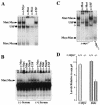
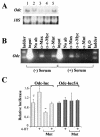

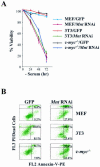

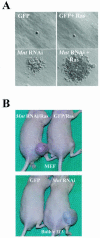

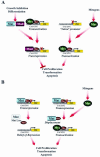
Similar articles
-
Mnt, a novel Max-interacting protein is coexpressed with Myc in proliferating cells and mediates repression at Myc binding sites.Genes Dev. 1997 Jan 1;11(1):44-58. doi: 10.1101/gad.11.1.44. Genes Dev. 1997. PMID: 9000049
-
Chromatin dynamics at the hTERT promoter during transcriptional activation and repression by c-Myc and Mnt in Xenopus leavis oocytes.Exp Cell Res. 2013 Dec 10;319(20):3160-9. doi: 10.1016/j.yexcr.2013.07.004. Epub 2013 Jul 13. Exp Cell Res. 2013. PMID: 23860446
-
Evidence of mnt-myc antagonism revealed by mnt gene deletion.Cell Cycle. 2004 Feb;3(2):97-9. Cell Cycle. 2004. PMID: 14712062 Review.
-
The MNT transcription factor autoregulates its expression and supports proliferation in MYC-associated factor X (MAX)-deficient cells.J Biol Chem. 2020 Feb 14;295(7):2001-2017. doi: 10.1074/jbc.RA119.010389. Epub 2020 Jan 9. J Biol Chem. 2020. PMID: 31919096 Free PMC article.
-
Mnt takes control as key regulator of the myc/max/mxd network.Adv Cancer Res. 2007;97:61-80. doi: 10.1016/S0065-230X(06)97003-1. Adv Cancer Res. 2007. PMID: 17419941 Review.
Cited by
-
Therapeutic Inhibition of Myc in Cancer. Structural Bases and Computer-Aided Drug Discovery Approaches.Int J Mol Sci. 2018 Dec 29;20(1):120. doi: 10.3390/ijms20010120. Int J Mol Sci. 2018. PMID: 30597997 Free PMC article. Review.
-
Mnt-Max to Myc-Max complex switching regulates cell cycle entry.J Cell Biol. 2005 May 9;169(3):405-13. doi: 10.1083/jcb.200411013. Epub 2005 May 2. J Cell Biol. 2005. PMID: 15866886 Free PMC article.
-
The direct Myc target Pim3 cooperates with other Pim kinases in supporting viability of Myc-induced B-cell lymphomas.Oncotarget. 2011 Jun;2(6):448-60. doi: 10.18632/oncotarget.283. Oncotarget. 2011. PMID: 21646687 Free PMC article.
-
The Multiple Faces of MNT and Its Role as a MYC Modulator.Cancers (Basel). 2021 Sep 18;13(18):4682. doi: 10.3390/cancers13184682. Cancers (Basel). 2021. PMID: 34572909 Free PMC article. Review.
-
Nucleophosmin suppresses oncogene-induced apoptosis and senescence and enhances oncogenic cooperation in cells with genomic instability.Carcinogenesis. 2007 Jun;28(6):1163-70. doi: 10.1093/carcin/bgm025. Epub 2007 Feb 2. Carcinogenesis. 2007. PMID: 17277230 Free PMC article.
References
-
- Askew, D. S., R. A. Ashmun, B. C. Simmons, and J. L. Cleveland. 1991. Constitutive c-myc expression in an IL-3-dependent myeloid cell line suppresses cell cycle arrest and accelerates apoptosis. Oncogene 6:1915-1922. - PubMed
-
- Ayer, D. E., and R. N. Eisenman. 1993. A switch from Myc:Max to Mad:Max heterocomplexes accompanies monocyte/macrophage differentiation. Genes Dev. 7:2110-2119. - PubMed
-
- Ayer, D. E., Q. A. Lawrence, and R. N. Eisenman. 1995. Mad-Max transcriptional repression is mediated by ternary complex formation with mammalian homologs of yeast repressor Sin3. Cell 80:767-776. - PubMed
-
- Baudino, T. A., K. H. Maclean, J. Brennan, E. Parganas, C. Yang, A. Aslanian, J. A. Lees, C. J. Sherr, M. F. Roussel, and J. Cleveland. 2003. Myc-mediated proliferation and lymphomagenesis, but not apoptosis, are compomised by E2f1 loss. Mol. Cell 11:1-20. - PubMed
Publication types
MeSH terms
Substances
Grants and funding
LinkOut - more resources
Full Text Sources
Research Materials
